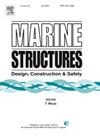水下复合材料圆柱体的二阶屈曲载荷
IF 5.1
2区 工程技术
Q1 ENGINEERING, CIVIL
引用次数: 0
摘要
本文利用变分原理,在求解非正交各向异性本构关系和离散拉格朗日应变中所有线性和非线性项影响的基础上,提出了一种新的水下复合材料潜水器非线性二阶屈曲载荷计算方法。对于半径厚度比14.11 ~ 68.70范围内的20个中等长度实验样品,该方法的最大预测误差为- 15.235%,最小预测误差为0.90%,平均预测误差为6.17%;16个标本的绝对预测误差在10%以内,19个标本的绝对预测误差在15%以内。对于半径厚度比为8.33 ~ 68.70,长半径比增加到24的22个实验试样,该方法的最大预测误差为- 18.85%,最小预测误差为0.90%,平均预测误差为6.98%;其中16个标本的绝对预测误差在10%以内,20个标本的绝对预测误差在15%以内。该方法具有良好的收敛性、稳定性和角阶抗扰性。与分析方法和商业有限元软件相比,该方法提高了预测精度,减小了预测误差波动范围。该方法解决了传统简支边界条件下商用有限元软件无法预测屈曲载荷的难题。22个试件中,有19个试件的预测结果较为保守,最大保守度为- 18.85%,在工程验收范围内。这有利于为海洋工程中水下复合潜水器的设计提供更充分的屈曲载荷安全裕度。本文章由计算机程序翻译,如有差异,请以英文原文为准。
Second order buckling load of underwater composite cylinder
In this paper, a novel nonlinear second-order buckling load computational method is proposed for underwater composite submersibles using variational principle while solving the effects of nonorthogonal anisotropic constitutive relationship and all linear and nonlinear terms in the discrete Lagrangian strain. For 20 medium-length experimental specimens in the range of 14.11∼68.70 radius-to-thickness ratios, the maximum prediction error of this method is -15.235 %, the minimum prediction error is 0.90 %, and the average prediction error is 6.17 %; the absolute prediction errors are within 10 % for 16 specimens, and within 15 % for 19 specimens. For the 22 experimental specimens in the range of 8.33 ∼ 68.70 radius-to-thickness ratios with length-to-radius ratio increasing up to 24, the maximum prediction error of the method is -18.85 %, the minimum prediction error is 0.90 %, and the average prediction error is 6.98 %; the absolute prediction error is within 10 % for 16 of the specimens, and within 15 % for 20 of the specimens. In addition, this method has good convergence, stability, and angle order immunity. The method improves the prediction accuracy and reduces the prediction error fluctuation range compared with analytical methods and commercial FEM software. The method solves the difficulty that commercial FEM software is unable to predict the buckling loads under classical simply supported boundary condition. Among the total 22 specimens, the prediction results about 19 of them shows conservative results, with the maximum degree of conservatism of -18.85 %, which is within the engineering acceptance range. This is conducive to providing a more adequate safety margin of buckling load for the design of underwater composite submersibles in offshore engineering.
求助全文
通过发布文献求助,成功后即可免费获取论文全文。
去求助
来源期刊

Marine Structures
工程技术-工程:海洋
CiteScore
8.70
自引率
7.70%
发文量
157
审稿时长
6.4 months
期刊介绍:
This journal aims to provide a medium for presentation and discussion of the latest developments in research, design, fabrication and in-service experience relating to marine structures, i.e., all structures of steel, concrete, light alloy or composite construction having an interface with the sea, including ships, fixed and mobile offshore platforms, submarine and submersibles, pipelines, subsea systems for shallow and deep ocean operations and coastal structures such as piers.
 求助内容:
求助内容: 应助结果提醒方式:
应助结果提醒方式:


